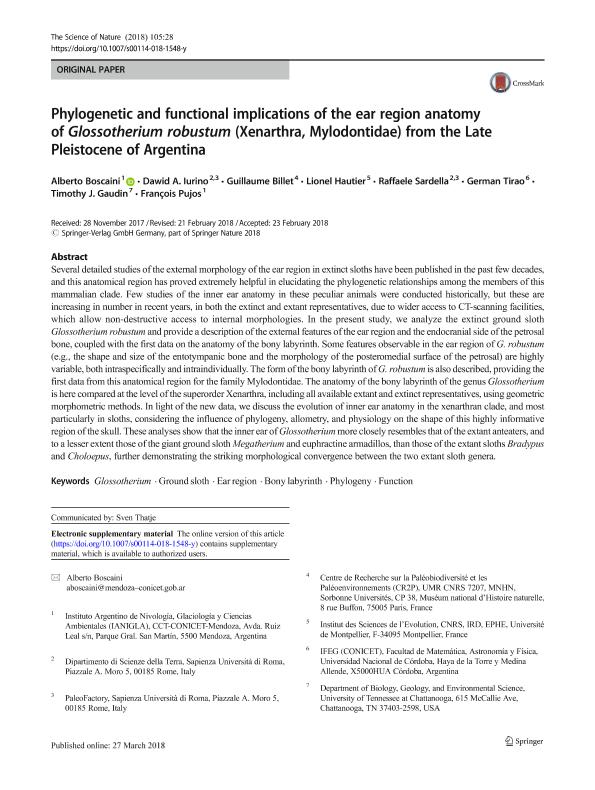Mostrar el registro sencillo del ítem
dc.contributor.author
Boscaini, Alberto

dc.contributor.author
Iurino, Dawid A.
dc.contributor.author
Billet, Guillaume
dc.contributor.author
Hautier, Lionel
dc.contributor.author
Sardella, Raffaele
dc.contributor.author
Tirao, German Alfredo

dc.contributor.author
Gaudin, Timothy

dc.contributor.author
Pujos, François Roger Francis

dc.date.available
2019-10-21T20:35:08Z
dc.date.issued
2018-04
dc.identifier.citation
Boscaini, Alberto; Iurino, Dawid A.; Billet, Guillaume; Hautier, Lionel; Sardella, Raffaele; et al.; Phylogenetic and functional implications of the ear region anatomy of Glossotherium robustum (Xenarthra, Mylodontidae) from the Late Pleistocene of Argentina; Springer; Naturwissenschaften; 105; 3-4; 4-2018; 1-18
dc.identifier.issn
0028-1042
dc.identifier.uri
http://hdl.handle.net/11336/86750
dc.description.abstract
Several detailed studies of the external morphology of the ear region in extinct sloths have been published in the past few decades, and this anatomical region has proved extremely helpful in elucidating the phylogenetic relationships among the members of this mammalian clade. Few studies of the inner ear anatomy in these peculiar animals were conducted historically, but these are increasing in number in recent years, in both the extinct and extant representatives, due to wider access to CT-scanning facilities, which allow non-destructive access to internal morphologies. In the present study, we analyze the extinct ground sloth Glossotherium robustum and provide a description of the external features of the ear region and the endocranial side of the petrosal bone, coupled with the first data on the anatomy of the bony labyrinth. Some features observable in the ear region of G. robustum (e.g., the shape and size of the entotympanic bone and the morphology of the posteromedial surface of the petrosal) are highly variable, both intraspecifically and intraindividually. The form of the bony labyrinth of G. robustum is also described, providing the first data from this anatomical region for the family Mylodontidae. The anatomy of the bony labyrinth of the genus Glossotherium is here compared at the level of the superorder Xenarthra, including all available extant and extinct representatives, using geometric morphometric methods. In light of the new data, we discuss the evolution of inner ear anatomy in the xenarthran clade, and most particularly in sloths, considering the influence of phylogeny, allometry, and physiology on the shape of this highly informative region of the skull. These analyses show that the inner ear of Glossotherium more closely resembles that of the extant anteaters, and to a lesser extent those of the giant ground sloth Megatherium and euphractine armadillos, than those of the extant sloths Bradypus and Choloepus, further demonstrating the striking morphological convergence between the two extant sloth genera.
dc.format
application/pdf
dc.language.iso
eng
dc.publisher
Springer

dc.rights
info:eu-repo/semantics/openAccess
dc.rights
Atribución-NoComercial-CompartirIgual 2.5 Argentina (CC BY-NC-SA 2.5 AR)
dc.rights.uri
https://creativecommons.org/licenses/by-nc-sa/2.5/ar/
dc.subject
BONY LABYRINTH
dc.subject
EAR REGION
dc.subject
FUNCTION
dc.subject
GLOSSOTHERIUM
dc.subject
GROUND SLOTH
dc.subject
PHYLOGENY
dc.subject.classification
Otras Ciencias Naturales y Exactas

dc.subject.classification
Otras Ciencias Naturales y Exactas

dc.subject.classification
CIENCIAS NATURALES Y EXACTAS

dc.title
Phylogenetic and functional implications of the ear region anatomy of Glossotherium robustum (Xenarthra, Mylodontidae) from the Late Pleistocene of Argentina
dc.type
info:eu-repo/semantics/article
dc.type
info:ar-repo/semantics/artículo
dc.type
info:eu-repo/semantics/publishedVersion
dc.date.updated
2019-10-16T20:35:28Z
dc.identifier.eissn
1432-1904
dc.journal.volume
105
dc.journal.number
3-4
dc.journal.pagination
1-18
dc.journal.pais
Alemania

dc.journal.ciudad
Berlin
dc.description.fil
Fil: Boscaini, Alberto. Consejo Nacional de Investigaciones Científicas y Técnicas. Centro Regional de Investigaciones Cientifícas y Tecnológicas; Argentina
dc.description.fil
Fil: Iurino, Dawid A.. Università degli studi di Roma "La Sapienza"; Italia
dc.description.fil
Fil: Billet, Guillaume. Muséum National d'Histoire Naturelle; Francia
dc.description.fil
Fil: Hautier, Lionel. Université de Montpellier; Francia
dc.description.fil
Fil: Sardella, Raffaele. Università degli studi di Roma "La Sapienza"; Italia
dc.description.fil
Fil: Tirao, German Alfredo. Consejo Nacional de Investigaciones Científicas y Técnicas. Centro Científico Tecnológico Conicet - Córdoba. Instituto de Física Enrique Gaviola. Universidad Nacional de Córdoba. Instituto de Física Enrique Gaviola; Argentina
dc.description.fil
Fil: Gaudin, Timothy. University of Tennessee; Estados Unidos
dc.description.fil
Fil: Pujos, François Roger Francis. Consejo Nacional de Investigaciones Científicas y Técnicas. Centro Científico Tecnológico Conicet - Mendoza. Instituto Argentino de Nivología, Glaciología y Ciencias Ambientales. Provincia de Mendoza. Instituto Argentino de Nivología, Glaciología y Ciencias Ambientales. Universidad Nacional de Cuyo. Instituto Argentino de Nivología, Glaciología y Ciencias Ambientales; Argentina
dc.journal.title
Naturwissenschaften

dc.relation.alternativeid
info:eu-repo/semantics/altIdentifier/url/http://link.springer.com/10.1007/s00114-018-1548-y
dc.relation.alternativeid
info:eu-repo/semantics/altIdentifier/doi/http://dx.doi.org/10.1007/s00114-018-1548-y
Archivos asociados
